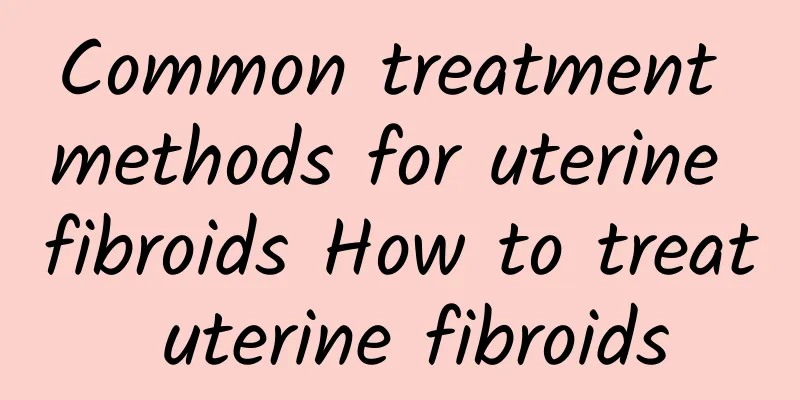Common treatment methods for uterine fibroids How to treat uterine fibroids

|
Now society has progressed, medical technology has also improved, and many treatment measures for uterine fibroids have been discovered, with very good treatment effects. Although many friends with uterine fibroids have a certain understanding of uterine fibroids, they are very confused about how to treat uterine fibroids. Different uterine fibroids can choose different treatment methods according to different situations. The following are several treatment methods for uterine fibroids 1. Conservative treatment Conservative treatment of uterine fibroids must meet the following conditions: the tumor size does not exceed 6 weeks of pregnancy; the patient is postmenopausal and asymptomatic; and the patient cannot tolerate the pain of surgery. Conservative treatment is divided into two categories: expectant treatment and drug treatment. 2. Surgical treatment The applicable conditions for surgical treatment are as follows: the size of the fibroid is close to the size of the pregnant uterus for more than one and a half months. However, if the fibroid grows rapidly, the fibroid protrudes from the abdominal cavity and has a tendency to twist, surgical resection should also be performed. Surgical treatment is divided into hysterectomy and hysterectomy and laparoscopic myomectomy. 3. Minimally invasive coagulation technique This is a high-end medical technology that integrates various electronic technologies. It is suitable for the following people: large uterine fibroids leading to pelvic congestion, obvious clinical compression or depression symptoms; uterine volume increase up to 3 months of pregnancy. Increased menstrual volume, severe secondary anemia. Causes of infertility caused by uterine fibroids (1) Larger uterine fibroids can deform the uterine cavity, which is not conducive to sperm passage, fertilized egg implantation and fetal development. (2) Fibroids growing near the uterine horns can compress the opening of the fallopian tubes, causing blockage. (3) Myomas growing within the lumen of the fallopian tube can stretch and twist the surface of the fallopian tube, squeeze the lumen, affect its patency, or displace the ovary, widen the distance between the ovary and the fallopian tube, and hinder the egg retrieval function of the fimbria of the fallopian tube. (4) Uterine fibroids growing in the cervix can compress the cervical canal, obstruct the passage or change the direction of the cervix, moving it away from the semen pool in the posterior fornix, making it difficult for sperm to enter the cervix. (5) Uterine fibroids growing under the mucosa of the uterine cavity are like a spherical intrauterine device, which hinders fertility. The ischemia, necrosis and atrophy of the endometrium on the surface of the uterine cavity are also not conducive to the implantation of the fertilized egg. (6) Uterine fibroids can cause the frequency, range, and duration of uterine contractions to exceed the normal baseline, interfering with the implantation of the fertilized egg or causing miscarriage after implantation. |
Recommend
Common knowledge about bacterial vaginosis
Many female friends are often troubled by this di...
What are the folk remedies for the treatment of uterine fibroids? How to treat uterine fibroids symptomatically?
What are the folk prescriptions for the treatment...
Your body shape determines how you exercise! Even people who don't gain weight should exercise
【A body shape that won’t gain weight】 If you are ...
What causes right lateral adnexitis?
Right-sided adnexitis is usually caused by a bact...
What are some good ways to treat dysmenorrhea?
What should you do if you have dysmenorrhea? In a...
What foods are suitable for patients with cervical warts?
Cervical warts are difficult to treat nowadays. W...
Explain the health care measures to prevent uterine fibroids
Uterine fibroids are the most common benign tumor...
Analysis of the most common causes of uterine fibroids
It is understood that many female friends are una...
What are the dangers of congenital absence of vagina?
I believe that everyone is not particularly famil...
Can pelvic effusion be cured after 4 days of treatment? How to prevent it?
Pelvic effusion is a very common female disease. ...
Drink tea to burn fat and reduce edema. 5 kinds of tea to drink for your condition
Did you know? Drinking tea can not only relax the...
Why does my stomach hurt during menstruation?
Why does my stomach hurt during menstruation? Dur...
How to abort an unexpected pregnancy
How to abort an unexpected pregnancy? Many people...
What should I do if my menstrual period is long and heavy?
What should I do if my menstrual period is long a...
What should I do if I always have irregular menstruation? Here are 5 good ways to help you regulate it easily!
Normally, the menstrual cycle is 28-30 days, but ...









